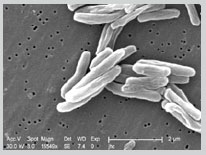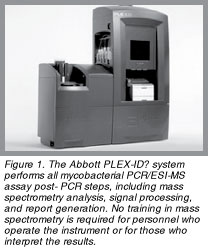Reducing the Spread of TB in China: New Technology Needed to Turn the Tide
by:David J. Ecker and Wenhong Zhang
TB Diagnosis and Treatment
 Mycobacterium tuberculosis kills roughly 1.5 million people annually. Accordingly to 2006 WHO estimates, more people were infected with tuberculosis (TB) in China than any country in the world except India. In China, TB kills more adults annually than any other infectious disease. In the WHO Global Plan to Stop TB, written in 2005, the directly observed therapy short-course (DOTS) strategy for global TB control was adopted; DOTS depends on case detection by sputum smear and empirical treatment regimens to interrupt transmission. It has now become clear, however, that 40 to 60% of TB-infected patients are smear-negative. In addition, drug resistance is not determined by a smear. Multidrug-resistant (MDR) TB, resistant to both isoniazid (INH) and rifampin (RIF), is estimated to infect a half million people worldwide and cannot be effectively treated with DOTS therapy.
Mycobacterium tuberculosis kills roughly 1.5 million people annually. Accordingly to 2006 WHO estimates, more people were infected with tuberculosis (TB) in China than any country in the world except India. In China, TB kills more adults annually than any other infectious disease. In the WHO Global Plan to Stop TB, written in 2005, the directly observed therapy short-course (DOTS) strategy for global TB control was adopted; DOTS depends on case detection by sputum smear and empirical treatment regimens to interrupt transmission. It has now become clear, however, that 40 to 60% of TB-infected patients are smear-negative. In addition, drug resistance is not determined by a smear. Multidrug-resistant (MDR) TB, resistant to both isoniazid (INH) and rifampin (RIF), is estimated to infect a half million people worldwide and cannot be effectively treated with DOTS therapy.
 According to WHO recommendations, patients with positive sputum smears after 5 months have failed treatment. A recent study quantified time to conversion from smear and culture positivity to negativity in tuberculosis patients receiving standardized therapy in a DOTS program in Lima, Peru. Such patients are almost certain to have MDR TB. It is detrimental both for the patient and public health to wait so many months before initiation of treatment with second-line drugs. Unfortunately, a positive smear on day 60 after the initiation of therapy was not a good predictor of multidrug resistance. It is becoming clear that in order to halt the TB epidemic in countries like China, universal rapid culture and baseline drug susceptibility testing (DST) must become standard in care.
According to WHO recommendations, patients with positive sputum smears after 5 months have failed treatment. A recent study quantified time to conversion from smear and culture positivity to negativity in tuberculosis patients receiving standardized therapy in a DOTS program in Lima, Peru. Such patients are almost certain to have MDR TB. It is detrimental both for the patient and public health to wait so many months before initiation of treatment with second-line drugs. Unfortunately, a positive smear on day 60 after the initiation of therapy was not a good predictor of multidrug resistance. It is becoming clear that in order to halt the TB epidemic in countries like China, universal rapid culture and baseline drug susceptibility testing (DST) must become standard in care.
The BD Mycobacteria Growth Indicator Tube (MIGT TM ) is a recently developed fluorescence-based assay that provides a positive identification of mycobacteria in 4 to 6 days. In culture-based assays, non-tuberculosis mycobacteria (NTM) infections can confound treatment decisions. The proper characterization of NTMs is critical as some species are known to be naturally resistant to one or more antitubercular agents and, under current testing paradigms, the presence of an NTM may be suspected only after the failure of a regular tuberculosis treatment. More rapid diagnosis and tests that provide sufficient information to allow physicians to decide on proper drug treatment are desperately needed in order to effectively halt the tuberculosis epidemics in countries like China.
Use of PCR/ESI-MS and the Abbott PLEX-ID for Simultaneous Speciation and Drug Resistance Determination
We recently validated an assay that employs PCR followed by amplicon characterization using electrospray ionization mass spectroscopy (PCR/ESI-MS) for the speciation and drug-resistance characterization of mycobacteria (Massire et al., in press). PCR/ESI-MS is a rapid, high-throughput method for identification and quantification of microorganisms present in cultured specimens or patient samples. The technology, known commercially as the Abbott PLEX-ID was reviewed recently in Nature Reviews Microbiology (Ecker et al., 6: 553-8, 2008) and has been validated for identification of bacterial species, viruses, and fungi. In the PCR/ESI-MS method, multiple pairs of primers are used to amplify carefully selected regions of pathogen genomes; the primer target sites are broadly conserved but the amplified regions carry information on the microbe抯 identity in the nucleotide base compositions. Following PCR amplification, a fully automated electrospray ionization mass spectrometry analysis is performed to effectively weigh the PCR amplicons with sufficient mass accuracy that the composition of A, G, C, and T can be deduced. The base composition signatures are compared to a database of calculated base compositions derived from the sequences of known organisms to identify pathogens present.
 The mycobacterial PCR/ESI-MS assay was validated with cultured organisms. The assay panel includes 16 primer pairs in eight multiplexed reactions; the base composition signatures of amplicons from these reactions allow speciation and determine the presence or absence of resistance genes for RIF, INH, ethambutol, fluoroquinolone and diarylquinoline. The PCR/ESI-MS assay was validated using a collection of 1340 DNA samples from cultured specimens. The PCR/ESI-MS assay has 89.3% sensitivity and 95.8% specificity in the determination of INH resistance and 96.3% sensitivity and 98.6% specificity in the determination of RIF resistance. Using a set of 264 previously characterized liquid culture specimens, the PCR/ESI-MS method had 97.0% sensitivity and 99.9% specificity for determination of NTM identity. The assay also provides information on resistance and lineage-specific polymorphisms to yield highly discriminative digital signatures suitable for epidemiology tracking. A major strength of the PCR/ESI-MS method is that the mass spectrometer is capable of analyzing an amplification reaction every 30 seconds. Using the Abbott PLEX-ID instrumentation (Figure 1), the process of nucleic acid isolation from a patient serum or sputum sample or from culture broth is completely automated.
The mycobacterial PCR/ESI-MS assay was validated with cultured organisms. The assay panel includes 16 primer pairs in eight multiplexed reactions; the base composition signatures of amplicons from these reactions allow speciation and determine the presence or absence of resistance genes for RIF, INH, ethambutol, fluoroquinolone and diarylquinoline. The PCR/ESI-MS assay was validated using a collection of 1340 DNA samples from cultured specimens. The PCR/ESI-MS assay has 89.3% sensitivity and 95.8% specificity in the determination of INH resistance and 96.3% sensitivity and 98.6% specificity in the determination of RIF resistance. Using a set of 264 previously characterized liquid culture specimens, the PCR/ESI-MS method had 97.0% sensitivity and 99.9% specificity for determination of NTM identity. The assay also provides information on resistance and lineage-specific polymorphisms to yield highly discriminative digital signatures suitable for epidemiology tracking. A major strength of the PCR/ESI-MS method is that the mass spectrometer is capable of analyzing an amplification reaction every 30 seconds. Using the Abbott PLEX-ID instrumentation (Figure 1), the process of nucleic acid isolation from a patient serum or sputum sample or from culture broth is completely automated.
Preliminary data with specimens from China
We have begun to use the mycobacterial PCR/ESI-MS assay to evaluate the prevalence of drug resistant TB in various regions of China. Ninety-six M. tuberculosis isolates were collected from Shanghai Pulmonary Disease Hospital (n=49) and Chongqing Pulmonary Disease Hospital (n=47). Species identification and drug susceptibility testing were performed according to the standards of NCCLS. Phenotypic testing was performed for each of these isolates by the absolute-concentration method on solid agar medium. DNA was extracted and the mycobacterial PCR/ESI-MS assay was performed. The drug-resistant gene mutations associated with RIF, INH, EMB, and FQ and genetic resistance types determined by PCR/ESI-MS were compared with phenotypic detections.
By PCR/ESI-MS, we found mutations conferring resistance to RIF in 76 of the 80 isolates determined to be RIF-resistant by standard phenotypic testing (95% sensitivity). For INH, mutations conferring resistance were found by PCR/ESI-MS in 65 of the 68 INH-resistant isolates (95.6% sensitivity). In addition, PCR/ESI-MS technology allowed us to determine the species of mycobacteria in the patient samples. Two primer pairs in this assay were designed for the determination of the PGG classification. The PGG classification provides valuable insights into the global phylogeny of sample collections and helps delineate clonal outbreaks. The percentages of PGG1, PGG2, and PGG3 in our patient samples were 87.5%, 10.4% and 2.1%, respectively. PGG1 was most prevalent in the eastern to southwestern regions of China (Wang et al., manuscript in preparation).
Future directions
Our preliminary data demonstrates that the mycobacterial PCR/ESI-MS PLEX-ID assay performed on the Abbott PLEX-ID is an accurate laboratory diagnostic tool that could be easily integrated into clinical diagnostic screening of patients for TB. The assay will be valuable for diagnosis and patient follow up and also for epidemiological tracking of pathogen spread. Recent work has demonstrated that the characterization of resistance mutations directly from sputum samples is achievable, and validation of the PCR/ESI-MS assay using direct sputum specimens is planned. Once the assay is validated for use directly from patient samples, diagnosis of TB would take less than a day.
The Abbott PLEX-ID system described here is available commercially and systems are currently in use in the United States and Europe. With the current system, all steps, including sample collection and preparation, and the automated PCR, mass spectrometry analysis, signal processing, and report generation, can be carried out by clinical laboratory personnel within a 4?-hour period. The mass spectrometer provides data every 30 seconds, uses no consumable products other than solvents, and can analyze approximately 2,500 PCR reactions in 24 hours in a completely automated fashion. No training in mass spectrometry is required for personnel who operate the instrument or for those who interpret the results. The PLEX-ID system has not yet been approved for use as a diagnostic tool. Once this regulatory hurdle is cleared, use of the mycobacterial PCR/ESI-MS assay will allow physicians to decide immediately on proper drug treatment. Rapid methods for diagnosis and drug susceptibility testing are desperately needed in order to effectively halt the spread of tuberculosis in countries like China.
SOURCE: Asia Pacific Biotech News (APBN)
- Cutting-edge Product for Stem Cell Research and Human Embryo Modelling 12/4/2025
- Thermo Fisher Scientific Launches Industry-First, Multi-Parameter Molecular Assa 11/20/2025
- Biotech Fluidics: Solvent Recyclers Improve HPLC System Sustainability 11/20/2025
- Titan Enterprises’ Beverage Flow Meters: Turbine vs. Ultrasonic – Which is Right 11/19/2025
- Gentle and Rapid Detachment of Even Delicate Adherent Cells 11/18/2025
- Simplifying Beam Diagnostics with a Laser Beam Reducer 11/18/2025
- Radiation Tolerant Lenses for Nuclear Monitoring Systems 11/14/2025
- SI Sensors: Lower Cost Custom CMOS Image Sensors 11/13/2025
- EpiCypher Launches Fiber-seq Kit to Democratize Single-Molecule Chromatin Mappin 11/12/2025
- Waters Announced the Launch of its Charged Aerosol Detector (CAD) 11/11/2025


